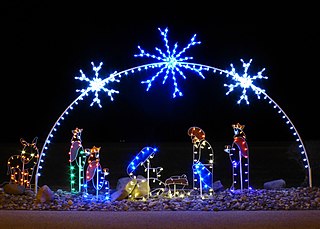
Christmas is an annual festival commemorating the birth of Jesus Christ, observed primarily on December 25 as a religious and cultural celebration among billions of people around the world. A feast central to the liturgical year in Christianity, it follows the season of Advent or the Nativity Fast, and initiates the season of Christmastide, which historically in the West lasts twelve days and culminates on Twelfth Night. Christmas Day is a public holiday in many countries, is celebrated religiously by a majority of Christians, as well as culturally by many non-Christians, and forms an integral part of the holiday season surrounding it.
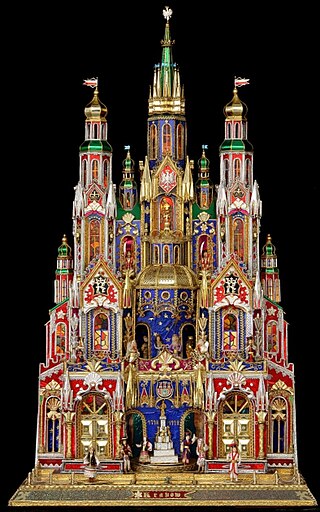
Christmas in Poland is a major annual celebration, as in most countries of the Christian world. The observance of Christmas developed gradually over the centuries, beginning in ancient times; combining old Polish pagan customs with the religious ones introduced after the Christianization of Poland by the Catholic Church. Later influences include the mutual permeating of local traditions and various folk cultures. It is one of the most important religious holidays for Poles, who follow a somewhat strict traditional custom. Christmas trees are decorated and lit in family rooms on the day of Christmas Eve. Other trees are placed in most public areas and outside churches. Christmas in Poland is called "Boże Narodzenie", which translates to 'God's Birth'.

A Christmas tree is a decorated tree, usually an evergreen conifer, such as a spruce, pine or fir, or an artificial tree of similar appearance, associated with the celebration of Christmas.

Advent is a season observed in most Christian denominations as a time of expectant waiting and preparation for both the celebration of the Nativity of Christ at Christmas and the return of Christ at the Second Coming. Advent is the beginning of the liturgical year in Western Christianity. The name was adopted from Latin adventus "coming; arrival", translating Greek parousia from the New Testament, originally referring to the Second Coming.

In the Christian tradition, a nativity scene is the special exhibition, particularly during the Christmas season, of art objects representing the birth of Jesus. While the term "nativity scene" may be used of any representation of the very common subject of the Nativity of Jesus in art, it has a more specialized sense referring to seasonal displays, in particular sets of individual sculptural figures and props that are arranged for display.

Christmas lights are lights often used for decoration in celebration of Christmas, often on display throughout the Christmas season including Advent and Christmastide. The custom goes back to when Christmas trees were decorated with candles, which symbolized Christ being the light of the world. The Christmas trees were brought by Christians into their homes in early modern Germany.

Christmas ornaments, baubles, globes, "Christmas bulbs", or "Christmas bubbles" are decoration items, usually to decorate Christmas trees. These decorations may be woven, blown, molded, carved from wood or expanded polystyrene, or made by other techniques.

Christmas is one of the biggest holidays in the Philippines. As one of the two predominantly Catholic countries in Asia, the Philippines celebrates the world's longest Christmas season ; Christmas music is played as early as August. The holiday season gradually begins by September, reaching its peak in December during Christmastide, and concludes within the week after New Year's Day, more specifically on the Sunday of Epiphany; however, festivities could last until the third Sunday of January, the feast day of the Santo Niño de Cebú. Liturgically, the Christmas season is observed by the Catholic Church in the Philippines from Christmas Day to the Feast of the Baptism of the Lord.

The observance of Christmas around the world varies by country. The day of Christmas, and in some cases the day before and the day after, are recognized by many national governments and cultures worldwide, including in areas where Christianity is a minority religion. In some non-Christian areas, periods of former colonial rule introduced the celebration ; in others, Christian minorities or foreign cultural influences have led populations to observe the holiday.
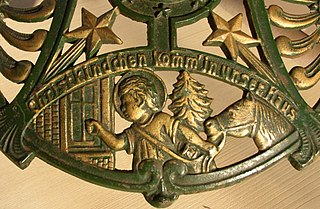
The Christkind, also called Christkindl, is the traditional Christmas gift-bringer in Austria, Switzerland, southern and western Germany, the Czech Republic, Croatia, Liechtenstein, Luxembourg, the eastern part of Belgium, Portugal, Slovakia, Hungary, parts of northeastern France, Upper Silesia in Poland, parts of Latin America, in certain areas of southern Brazil, and in the Acadiana region of Louisiana. Christkind is called in Portuguese Menino Jesus, in Hungarian Jézuska, in Slovak Ježiško, in Czech Ježíšek, in Latin America Niño Dios or Niño Jesús and in Croatian Isusić or Isusek, in Silesian Dziyciōntko Jezus, in Cieszyn Silesian Aniołek, in Polish Dzieciątko. In some parts of Italy, the analogous figure of the Christkind is known as Gesù Bambino.
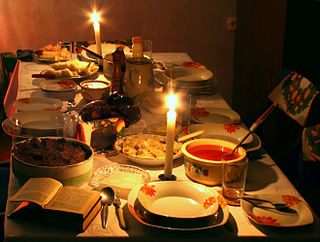
Wigilia is the traditional Christmas Eve vigil supper in Poland, held on December 24. The term is often applied to the whole of Christmas Eve, extending further to Pasterka—midnight Mass, held in Roman Catholic churches all over Poland and in Polish communities worldwide at or before midnight. The custom is sometimes referred to as "wieczerza" or "wieczerza wigilijna", in Old Polish meaning evening repast, linked to the late church service, Vespers from the Latin.

A Christmas decoration is any of several types of ornamentation used at Christmastide and the greater holiday season. The traditional colors of Christmas are pine green (evergreen), snow white, and heart red. Gold and silver are also prevalent, as are other metallic colours. Typical images on Christmas decorations include Baby Jesus, Mother Mary, angels, Father Christmas, Santa Claus, and the star of Bethlehem. Advent wreaths, nativity scenes, illuminations, and Moravian stars are popular Christmas decorations.

"Simpsons Christmas Stories" is the ninth episode of the seventeenth season of the American animated television series The Simpsons. It originally aired on the Fox network in the United States on December 18, 2005.
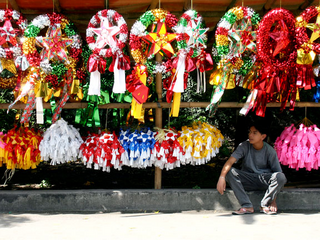
A parol is a Filipino ornamental lantern displayed during the Christmas season. Parols are traditionally constructed using bamboo and Japanese paper, and are illuminated with candles, oil lamps, or carbide lamps. Modern parols can be made using other materials such as plastic, metal, and capiz shells and are usually illuminated with electric lighting. Its most-common form is a five-pointed star, although it can come in various shapes and sizes. Large disc-shaped electronic versions of parols produced in Pampanga are known as "parul sampernandu", the phonetic spelling of parol San Fernando, owing to the city where these lanterns are a major product.

Christmas in Mexico is observed from December 12 to January 6, with one additional celebration on February 2. Traditional decorations displayed on this holiday include nativity scenes, poinsettias, and Christmas trees. The season begins with celebrations related to the Virgin of Guadalupe, the Patroness of Mexico, followed by traditions such as Las Posadas and Pastorelas.

Christmas is celebrated throughout December and traditionally until St. Knut's Day on January 13. The main celebration and the exchange of gifts in many families takes place on Christmas Eve, December 24. The Feast of St. Lucy, a high point in the Swedish Christmas season, is celebrated during Advent, on December 13.

Saving Christmas is a 2014 American faith-based Christmas comedy film. It was directed by Darren Doane and written by Doane and Cheston Hervey, based on an original story by Kirk Cameron. It was theatrically released by Samuel Goldwyn Films on November 14, 2014.

The Legend of the Christmas Spider is an Eastern European folktale which explains one possible origin of tinsel on Christmas trees. It is most prevalent in Western Ukraine, where small ornaments in the shape of a spider are traditionally a part of the Christmas decorations.

Christmas in France is a major annual celebration, as in most countries of the Christian world. Christmas is celebrated as a public holiday in France on December 25, concurring alongside other countries.

Christmas traditions include a variety of customs, religious practices, rituals, and folklore associated with the celebration of Christmas. Many of these traditions vary by country or region, while others are practiced virtually identically worldwide.
























